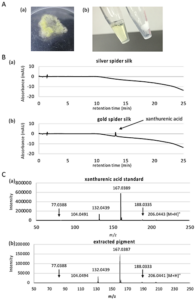DOI:110.3390/biom11040563
- 1. Institute for Advanced Biosciences, Keio University
- 2. Systems Biology Program, Graduate School of Media and Governance, Keio University
- 3. Biomacromolecules Research Team, RIKEN Center for Sustainable Resource Science
- 4. Spiber Inc.
- 5. Faculty of Environment and Information Studies, Keio University

From “From “Multicomponent nature underlies the extraordinary mechanical properties of spider dragline silk” license approved by copyright holders.
Abstract
Spider silk is a natural fiber with remarkable strength, toughness, and elasticity that is attracting attention as a biomaterial of the future. Golden orb-weaving spiders (Trichonephila clavata) construct large, strong webs using golden threads. To characterize the pigment of golden T. clavata dragline silk, we used liquid chromatography and mass spectrometric analysis. We found that the major pigment in the golden dragline silk of T. clavata was xanthurenic acid. To investigate the possible function of the pigment, we tested the effect of xanthurenic acid on bacterial growth using gram-negative Escherichia coli and gram-positive Bacillus subtilis. We found that xanthurenic acid had a slight antibacterial effect. Furthermore, to investigate the UV tolerance of the T. clavata threads bleached of their golden color, we conducted tensile deformation tests and scanning electron microscope observations. However, in these experiments, no significant effect was observed. We therefore speculate that golden orb-weaving spiders use the pigment for other purposes, such as to attract their prey in the sunlight.